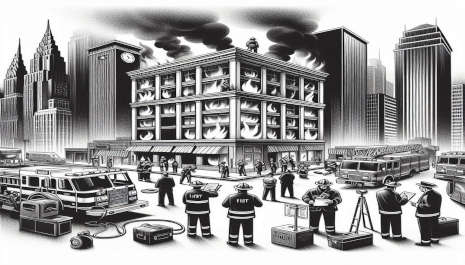How to Fail Your Municipal Building Inspections: Common Fire Safety Violations.

By Murray Wennerlund published 11-25-2024 updated 11-25-2024
Expanded ICC Codes and Reasons for Inspection Failures
- Are there any fire-resistive rated walls, floors, and/or ceilings?
- IBC Chapter 7: Non-compliance with fire-resistive rated assemblies.
- IRC Chapter 7: Missing or improperly installed fire-resistive rated assemblies.
- Copies of the UL listed fire-stop system(s) on site and available for review by Fire Inspector
- IBC Chapter 7: Lack of documentation.
- Verify that the UL listed fire-stop system(s) has been installed in accordance with the listing(s)
- IBC Chapter 7: Improper installation.
- IFC Chapter 7: Fire-stop systems not installed according to UL listings.
- Are all fire-stop systems readily "visible and accessible" by ladder or lift for fire inspection?
- IBC Chapter 7: Accessibility issues.
- IFC Chapter 7: Fire-stop systems not accessible.
- Is there an "independent" fire-stop contractor/installer?
- IBC Chapter 7: Lack of independent fire-stop contractor.
- "Head of Wall" Fire Stop System installed according to UL listings?
- IBC Chapter 7: Incorrect installation.
- "Wall to Wall" Fire Stop System installed according to UL listings?
- IBC Chapter 7: Incorrect installation.
- "Floor to Wall" Fire Stop System installed according to UL listings?
- IBC Chapter 7: Incorrect installation.
- Fire Resistive Wall "Through-Penetrations" installed according to ASTM E 814 or UL 1479, and in accordance with UL Listing(s)?
- IBC 712.3: Non-compliance with ASTM E 814 or UL 1479.
- Fire Resistive Wall "Membrane-Penetrations" installed in accordance with IBC 712.3.1?
- IBC 712.3.1: Non-compliance with membrane-penetrations requirements.
- Fire Resistive "Horizontal assemblies" (Floor and/or Ceiling) Fire Stop Systems(s) installed according to UL listings and IBC 712.4?
- IBC 712.4: Non-compliance with horizontal assemblies requirements.
- Light Fixtures enclosures installed with proper fire resistive "membrane Penetrations" per IBC 712.4.1.2
- IBC 712.4.1.2: Improper installation of light fixtures enclosures.
- Non-Fire Resistive "Horizontal assemblies" (Floor and/or Ceiling) Fire Stop System(s) installed according to UL listings and IBC 712.4.2?
- IBC 712.4.2: Non-compliance with non-fire resistive horizontal assemblies requirements.
- Combustible plumbing pipe sizes greater than 3 inches in diameter must be provided with "collars" (showing locations) and provide UL listings
- IBC Chapter 7: Lack of collars for combustible plumbing pipes.
- Fire Dampers "installed" and "pre-tested" in Fire Resistive Walls in accordance with UL 555 and in accordance with IBC Table 716.3.1?
- IBC 716.3.1: Fire dampers not installed or pre-tested according to UL 555 and IBC Table 716.3.1.
- Are they readily "accessible" for testing by fire inspectors with approved "access panels"?
- IBC Chapter 7: Fire dampers not accessible for testing.
- Are the dampers "labeled" in accordance with IBC 716.4? HVAC Duct and Air Transfer Openings (Ceilings and Floors)
- IBC 716.4: Dampers not labeled correctly.
- "Ceiling Radiation" Fire Dampers "installed" and "pre-tested" in accordance with UL 555c, IBC 716.6.6.2.1, and in accordance with IBC Table 716.3.1?
- IBC 716.6.6.2.1: Ceiling radiation fire dampers not installed or pre-tested according to UL 555c and IBC Table 716.3.1.
- Are they readily "accessible" for testing?
- IBC Chapter 7: Dampers not accessible for testing.
- Are the dampers "labeled" in accordance with IBC 716.4?
- IBC 716.4: Dampers not labeled correctly.
- All electrical wiring is installed and supported properly by building structural beams/columns/trusses per NFPA 70-Article 760?
- IBC Chapter 27: Improper installation and support of electrical wiring.
- Attic Access Panels installed with adequate opening size and head space?
- IBC Chapter 7: Inadequate attic access panels.
- Location of Lighted Exit Signs with battery backup installed in accordance with plans?
- IBC Chapter 10: Lighted exit signs not installed correctly.
- Location of Emergency Lighting with battery backup installed in accordance with plans?
- IBC Chapter 10: Emergency lighting not installed correctly.
- Draft Stop installed in Attic Space in accordance with plans?
- IBC Chapter 7: Draft stops not installed in attic space.
- Draft Stop installed in "floor/ceiling" assemblies in accordance with plans?
- IBC Chapter 7: Draft stops not installed in floor/ceiling assemblies.
- All wiring and ceiling mounted fire alarm devices (smoke detectors) visible and accessible?
- IBC Chapter 9: Fire alarm devices not visible and accessible.
- Are all plenum rated materials installed in accordance with IMC 602.2.1?
- IMC 602.2.1: Plenum rated materials not installed according to the code.

